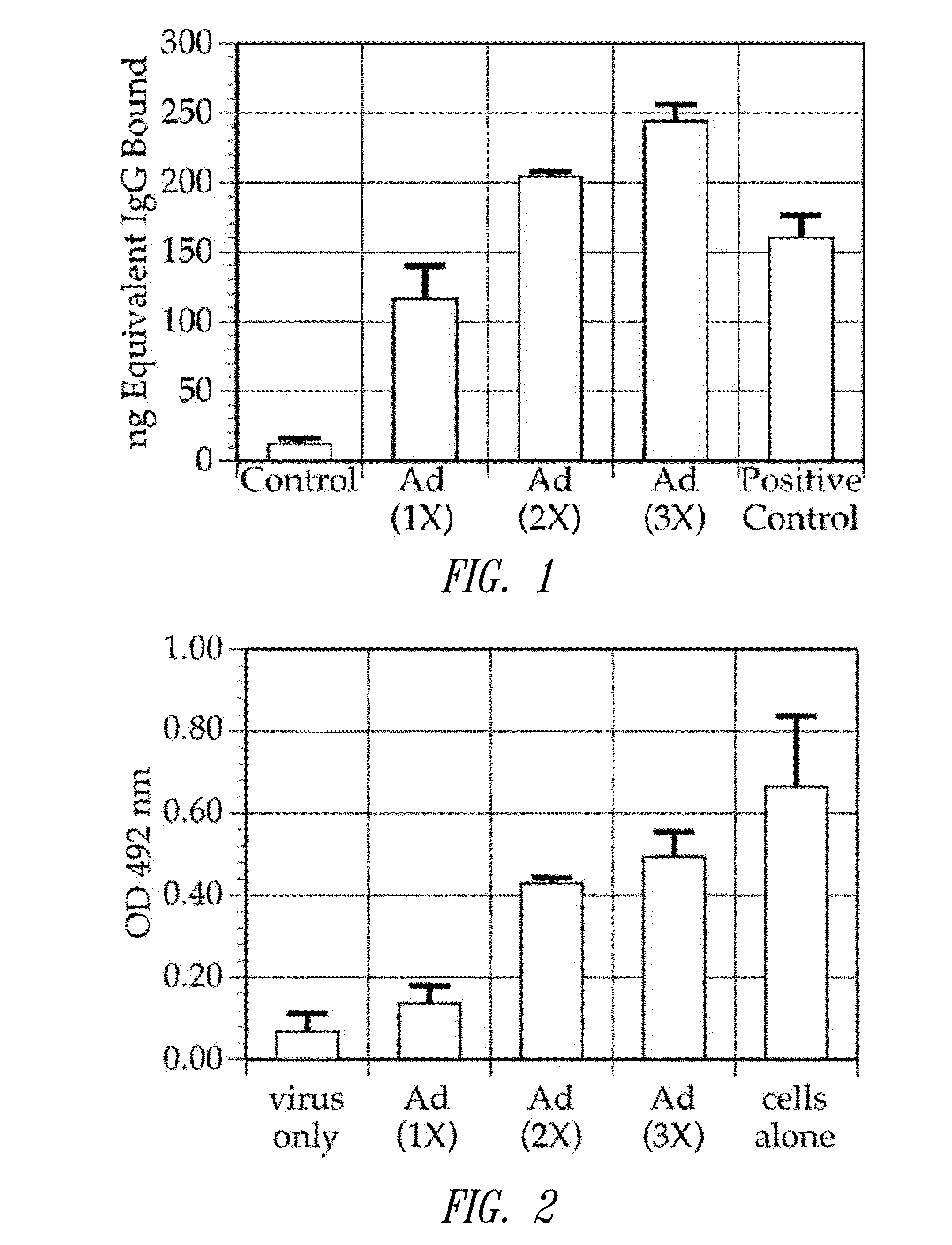Sequential administration of a replication defective adenovirus vector in vaccination protocols
a technology of replication defect and vaccine protocol, which is applied in the direction of viruses, growth factor/regulator receptors, drug compositions, etc., can solve the problems of severe limitation of the use of first-generation adenovirus vector vaccines, inability to sustain long-term transgene expression, and inability to achieve long-term transgene expression
- Summary
- Abstract
- Description
- Claims
- Application Information
AI Technical Summary
Benefits of technology
Problems solved by technology
Method used
Image
Examples
example 1
Multiple Injections of Ad5Null Adenovirus Vector Produces Anti-Adenovirus Antibodies
[0159]This example shows that multiple injections of Ad5-null results in the production of anti-adenovirus antibodies in the injected subjects
[0160]It was demonstrated that the Ad5Null adenovirus vector that does not contain any heterologous nucleic acid sequences, generates a neutralizing immune response in mice. In particular, in one experiment, female Balb / c mice aged 5-7 weeks were immunized with Ad5Null viral particles at 14 day intervals. To determine the presence of anti-adenovirus antibodies, an enzyme linked immunosorbent assay (ELISA) was used. For this ELISA, 109 viral particles were coated onto microtiter wells in 100 μL of 0.05M carbonate / bicarbonate buffer, pH 9.6, and incubated overnight at room temperature. For a standard immunoglobulin G (IgG) reference curve, 200 ng, 100 ng, 50 ng, 25 ng, and 0 ng of purified mouse IgG (Sigma Chemicals) were coated onto microtiter wells as described...
example 2
Multiple Injections of an E2b Deleted Adenovirus Vector Generates an Immune Response Against Target Antigens
[0164]This example shows that multiple injections of an E2b deleted adenovirus vector containing HIV-gag results in the production of HIV-gag immunity.
[0165]Two groups of mice were used for this experiment. One group served as a normal control group. The second group was injected 3 times with E2b deleted Ad containing HIV-gag at 2 week intervals. Four weeks after the last injection, mice were bled and assessed for IgG antibody levels using an ELISA assay as follows: For this assay, 100 ng of a purified mixture of HIV-gag proteins p17 / p24 were coated onto microtiter wells in 100 μL of 0.05M carbonate / bicarbonate buffer, pH 9.6, and incubated overnight at room temperature. For a standard IgG reference curve, purified mouse IgG (SigmaChemicals) in quantities of 200 ng, 100 ng, 50 ng, 25 ng, and 0 ng were coated onto microtiter wells as described above. After incubation, all wells...
example 3
Multiple Injections of an E2b Deleted Adenovirus Vector Generates an Immune Response Against Multiple Target Antigens
[0167]This example demonstrates that mice injected multiple times with an E2b deleted adenovirus vector vaccine expressing a first target antigen (HIV-gag) and subsequently injected multiple times with an E2b deleted adenovirus vector expressing a second target antigen (β-galactosidase) produce an immune response against the first and the second antigen.
[0168]A group of five mice were injected 3 times at 2 week intervals with 1010 E2b deleted adenovirus vector vaccine containing the HIV-gag gene. Four weeks later, the mice were injected two times at a weekly interval with 1010 E2b deleted adenovirus vector vaccine containing β-galactosidase. A group of 5 mice served as a normal control group. Sera from mice injected only with E2b deleted Ad-βgal that showed high levels of β-galactosidase IgG antibody served as a positive control.
[0169]To determine the presence of β-ga...
PUM
| Property | Measurement | Unit |
|---|---|---|
| pH | aaaaa | aaaaa |
| length of time | aaaaa | aaaaa |
| volume | aaaaa | aaaaa |
Abstract
Description
Claims
Application Information
 Login to View More
Login to View More - R&D
- Intellectual Property
- Life Sciences
- Materials
- Tech Scout
- Unparalleled Data Quality
- Higher Quality Content
- 60% Fewer Hallucinations
Browse by: Latest US Patents, China's latest patents, Technical Efficacy Thesaurus, Application Domain, Technology Topic, Popular Technical Reports.
© 2025 PatSnap. All rights reserved.Legal|Privacy policy|Modern Slavery Act Transparency Statement|Sitemap|About US| Contact US: help@patsnap.com



